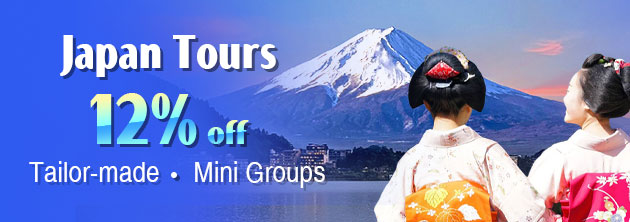Osaka Festivals
Osaka’s festivals are living legends—where 4-ton floats defy physics, sumo titans shake the earth, and fireworks paint symphonies. From Shinto chants to rivers ablaze, these rituals pulse with centuries of tradition, inviting travelers to witness 2025’s most breathtaking fusion of sacred craft and raw human spirit.Ebisu Festival (Jan. 9-11): Welcome Prosperity in the New Year
The Ebisu Festival honors Ebisu, Japan’s indigenous deity of commerce and prosperity who is particularly revered in Osaka where Shinto traditions merge seamlessly with commercial culture. In Osaka, the festival is usually celebrated at Imamiya Ebisu Shrine and Horikawa Ebisu Shrine, featuring dynamic rituals that bless both businesses and households.
Visitors can purchase fukusasa which are bamboo branches with Ebisu figures. It is believed that the branches will bring prosperity to homes or businesses if you dispose them at home or work place.
Where & How to Get There
Imamiya Ebisu Shrine: 16-minute walk from Namba Subway StationHorikawa Ebisu Shrine: 14-minute walk from Higashi-Umeda Subway Station
Setsubun Festival (Feb. 3): Chase Demons, Grab Luck!
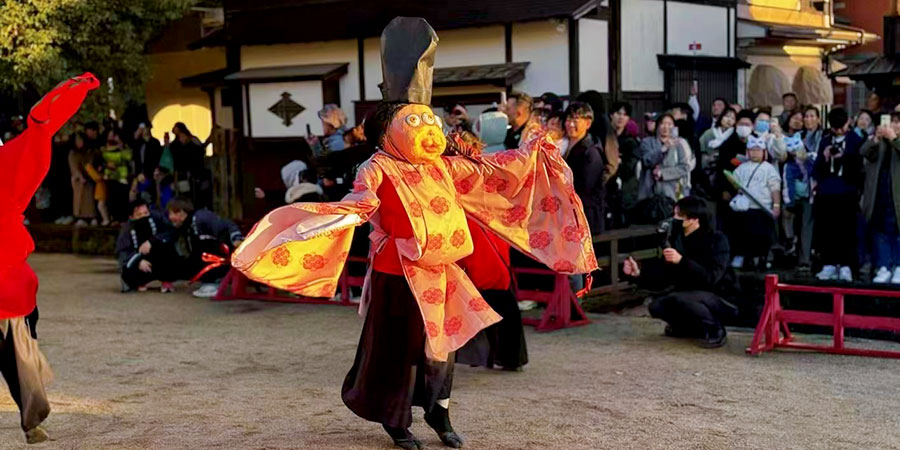
Demon Dance, Setsubun Festival
|
Rooted in Japan’s ancient belief that seasonal shifts awaken restless spirits, Setsubun marks the symbolic expulsion of winter’s darkness.
During the festival, people gather to celebrate spring’s arrival by banishing demons (oni) with roasted soybeans. Chant “Oni wa soto! Fuku wa uchi!” (“Demons out, luck in!”) and toss beans to purify homes—then eat your age’s count for health. At night, devour an Ehomaki sushi roll in silence while facing the year’s lucky direction (ehō) to manifest wishes.
Don’t miss the Setsubun Yokai Parade at Dojima Yakushido Temple, where performers in striking demon makeup lead processions amid drumming and dragon dances. Nearby, the historic Abiko Kannon Temple buzzes with rituals to ward off misfortune.
Where & How to Get There
Abiko Kannon Temple: 15-min walk from Abiko Station on Midosuji Subway LineDojima Yakushido Temple: 4-min walk from Nishi-Umeda Station Exit 7-B
Sumo Tournament (Mar. 9–23): Witness Japan’s Living Legacy of Power
|
|
|
Every March Osaka’s Edion Arena becomes a battleground of raw intensity as sumo—the national sport of Japan with a 1,500-year ritualistic tradition—takes center stage. Wrestlers in ceremonial loincloths (mawashi) compete in explosive sumo matches where they must send opponents beyond the sacred clay ring (dohyo) or to the ground to win.
Tip: Matches peak after 3:30 PM. Arrive by 3:00 PM for premier bouts (till 6:00 PM).
For hands-on immersion, head to THE SUMO HALL Nichirakuza OSAKA, where visitors can savor chanko-nabe—the protein-rich stew fueling wrestlers—while watching live demonstrations. Step onto a replica dohyo for photos, or test your mettle: daily lottery winners can spar with retired wrestlers.
Where & How to Get There
Edion Arena Osaka: 4-min walk from Namba Subway Station Exit 5.Sumo Hall Nichirakuza: 9-min walk from the same exit.
Admission Fee
Osaka Sumo Tournament: Ringside seats – 20,000 yen, box seats pricing from 22,000 yen for 2 guests, chair seats pricing from 3,500 yen for 1 guestSumo Experience (THE SUMO HALL Nichirakuza OSAKA, 13:30~14:45): 14,000 yen
Otaue-shinji Ritual (Jun. 14, 1:00–3:00 PM): Pray for a Golden Harvest
Rooted in Shinto beliefs that link rice cultivation to divine blessings, Osaka’s Sumiyoshi Taisha Shrine hosts one of Japan’s Three Great Rice-Planting Festivals to celebrate the sacred bond between humans, land, and kami (deities).
Get to the shrine’s field to see ceremonial ox pulls a wooden plow, followed by women dressed as Ueme (planting maidens) transplanting shoots with rhythmic precision. It comes to the climax when eight shrine maidens perform the graceful Yaotome-no-Mai, local children enact lively Taue Odori folk dances, and drummers close with the thunderous Sumiyoshi Odori.
Where & How to Get There
Sumiyoshi Taisha Shrine: 9-min ride via Nankai Main Line from Namba Station to Sumiyoshi Taisha Station

Traditional Japanese Wedding, Sumiyoshi Shrine
|
Aizendo Festival (Jun. 30–Jul. 2): Pray for Love & Prosperity

Pray for Love in Aizendo Festival
|
Young women in vibrant yukata ride a Hoekago palanquin draped in red-white cloth and morning glories, parading through Tennoji’s streets to chants of “Aizen-sama, Hoekago!” The procession ends at the temple’s Aizendō Hall, symbolizing summer’s arrival.
Don’t miss Shoman-in’s Tahōtō Pagoda—Osaka’s oldest wooden structure—where the rarely displayed Dainichi Buddha statue and Edo-period murals are unveiled exclusively during the festival.
Where & How to Get There
Aizendo Shoman-in Temple: 15-min walk from Tennoji Subway StationTanjin Matsuri (Jul. 24–25): Osaka’s Fire & Water Spectacle
|
|
|
On July 23, watch 80 women haul a 200kg mikoshi (portable shrine) through Tenjinbashi-suji, Japan’s longest shopping arcade, chanting prayers in a riveting prelude.
The climax unfolds on July 25: A 3,000-strong parade in Edo-period finery marches from Osaka Tenmangu Shrine to the Okawa River at noon (Rikutogyu), followed by ornate boats carrying deities gliding downstream at dusk (Funatogyu) to thunderous taiko drums.
As night falls, 5,000 fireworks—including the shrine’s signature red plum-shaped bursts—explode over 100 lantern-lit boats on the river. Secure early spots at Honjokawasaki Park or Sakuranomiya Park for the best views.
Where & How to Get There
Pre-festival procession
Tenjinbashi Arcade, 13-min bus ride (No. 83) from Osaka Station.
Main shrine events
Tenmangu Shrine, 25-min walk from Umeda Station.
Fireworks
Honjokawasaki Park, 25-min walk from Umeda Station.Sakuranomiya Park, 2-min walk from Sakuranomiya Station (JR Loop Line).
Sumiyoshi Matsuri (Jul. 30–Aug. 1): Cleanse Half a Year, Embrace Renewal

Sumiyoshi Sorihashi Bridge
|
As Osaka’s final summer ritual, the Sumiyoshi Matsuri at the head shrine of 2,300 Sumiyoshi branches nationwide blends purification rites and divine spectacle.
On July 31, join the Nagoshibarai ceremony: participants clad in Muromachi-period (1336–1573) costumes pass through towering sacred reed rings three times, symbolically shedding six months’ misfortunes.
The August 1 Shinkō Togyu procession steals the show. Bearers maneuver an 11-meter, 2-ton mikoshi (portable shrine) across the steep Sorihashi Bridge and through the Yamato River to Sakai City’s Tongu resting shrine. The crowd erupts as they tilt the shrine violently—a thrilling display believed to please the gods and ensure prosperity.
Tip: Foreign visitors can apply via the shrine’s website from June to join the mikoshi-carrying teams.
Where & How to Get There
Sumiyoshi Taisha Shrine: 9-min ride on Nankai Line from Namba Station.Yodogawa Firework Festival: When Music & Fireworks Collide

Go to Yodogawa Firework Festival in Yukata
|
As western Japan’s largest pyrotechnic event, Osaka’s Yodogawa Festival ignites the night with 20,000 shells choreographed to symphonic scores. The timed explosions of sakura blossoms and cascading willows align perfectly with the musical crescendos while laser beams and colored smoke heighten the dramatic effect.
Put on a yukata (summer kimono) and walk along the riverbank while capturing the moment when fireworks turn the sky into a transient display of gold and crimson.
Crowds cheer as synchronized sequences transform the Yodogawa River into a shimmering canvas.
When to See
Traditionally held in August, Yodogawa Fireworks Festival has been rescheduled to October 18, 2025, to align with the Osaka-Kansai Expo, a global event hosted in Japan that year.Where & How to Get There
Yodogawa Riverbed (Osaka City):JR Kobe Line to Tsukamoto Station → 10-min walk south.
Hankyu Kyoto/Kobe/Takarazuka Lines to Juso Station → 10-min walk south.
Kishiwada Danjiri Festival (Sept. 14–15): Where Courage Meets Craftsmanship

Kishiwada Danjiri Festival, Osaka
|
For over 300 years, Osaka’s Kishiwada Danjiri Festival has redefined bravery. Teams of 500 haul 4-ton wooden floats through narrow streets at breakneck speeds, executing perilous 90-degree turns without slowing—a feat locals call “ikadaoshi” (float tilting).
These 34 masterpieces, each requiring a year to carve, reject gilded opulence. Artisans instead etch folklore scenes and peony motifs directly into untreated wood, earning them the title “moving art museums”. As dusk falls at 7 PM, 200 lanterns illuminate the floats for yoru-danjiri (night procession), transforming kinetic fury into haunting elegance.
Visitor Note: Arrive early to secure viewing spots for daytime thrills and nighttime solemnity.
Where & How to Get There
Kishiwada Castle: 40-min ride on Nankai Line from Namba Station.You May Like
-
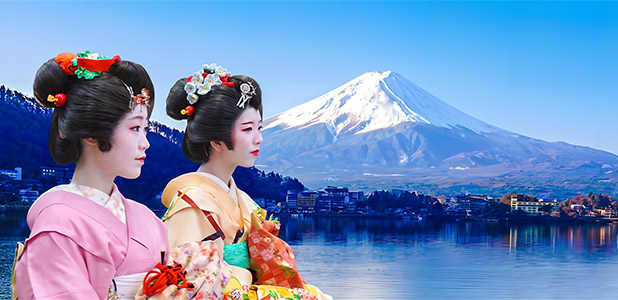 10 Days Private Tour of Tokyo - Mt. Fuji - Tokyo - Nagano - Matsumoto - Nakasendo Way - Kyoto - Osaka from USD2859
10 Days Private Tour of Tokyo - Mt. Fuji - Tokyo - Nagano - Matsumoto - Nakasendo Way - Kyoto - Osaka from USD2859 -
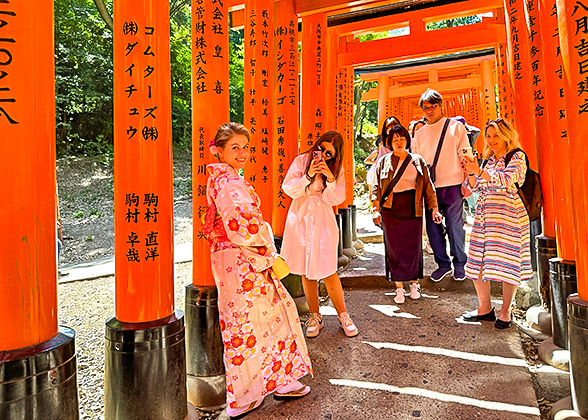 7 Days Mini Group Tour for Essence of Japan: Tokyo - Mt. Fuji - Kyoto - Nara - Osaka from USD2155
7 Days Mini Group Tour for Essence of Japan: Tokyo - Mt. Fuji - Kyoto - Nara - Osaka from USD2155 -
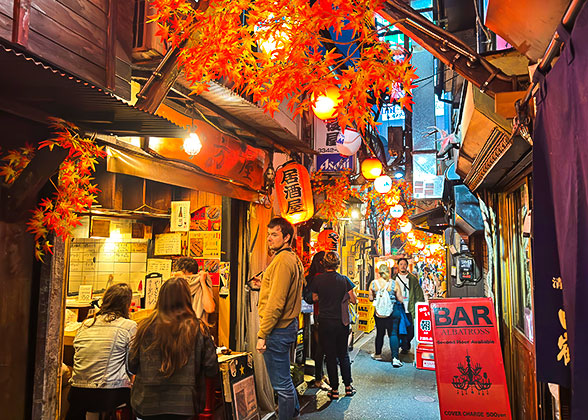 8 Days Mini Group Tour to Tokyo - Hakone & Mt. Fuji - Kyoto - Nara - Osaka - Hiroshima - Osaka from USD2771
8 Days Mini Group Tour to Tokyo - Hakone & Mt. Fuji - Kyoto - Nara - Osaka - Hiroshima - Osaka from USD2771

